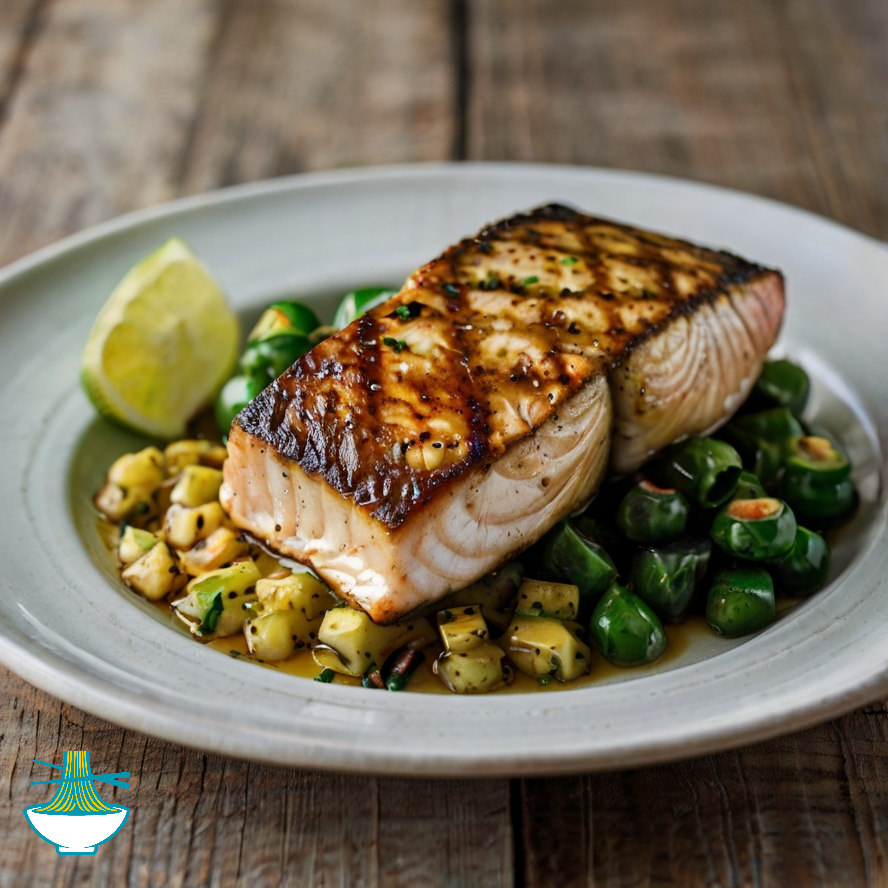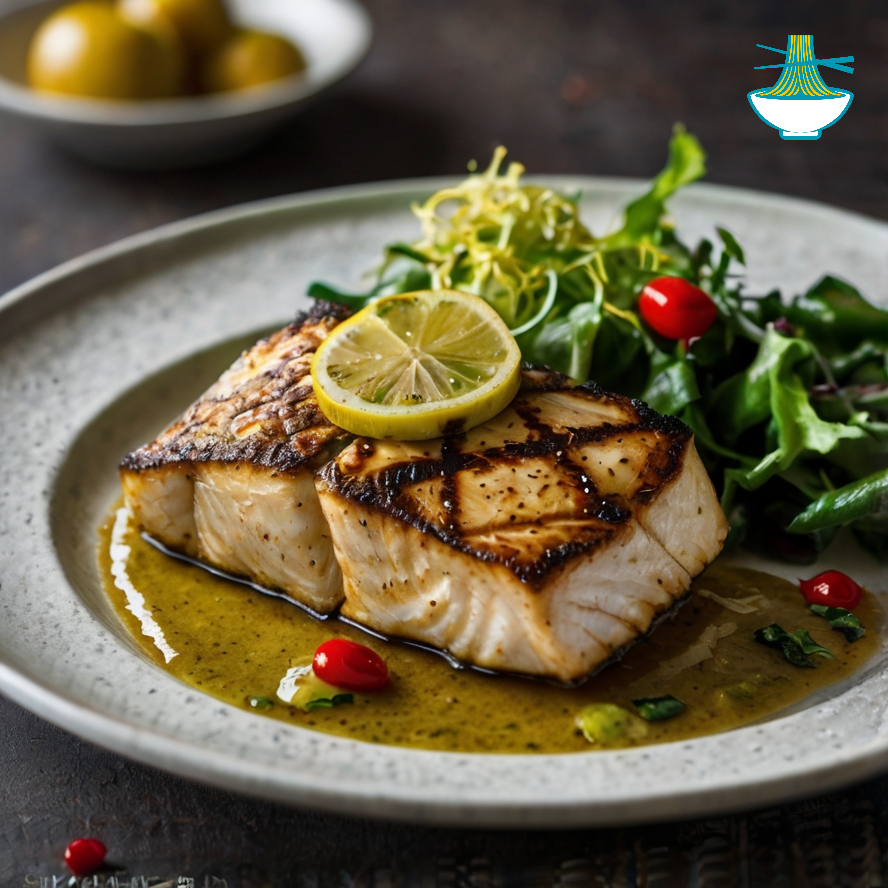Mahi Mahi, a lean and flavorful fish, is a popular choice for seafood lovers. It is an excellent source of protein, omega-3 fatty acids, and essential vitamins like vitamin B12 and selenium, which support heart health, brain function, and immune defense. The fish is low in calories and saturated fat, making it an ideal option for a healthydiet. While it’s packed with benefits, some people should watch their mercury intake when consuming large quantities of fish. Enjoyed grilled or pan-seared, Mahi Mahi is a versatile and delicious choice for any meal.
Ingredients:
- 4 Mahi Mahi fillets (about 6 ounces each)
- 2 tablespoons olive oil
- 1 teaspoon paprika
- 1 teaspoon garlic powder
- ½ teaspoon cayenne pepper (optional)
- Salt and black pepper to taste
- 1 lemon, sliced (for serving)
- Fresh parsley, chopped (for garnish)
Ingredient Substitutions
Can I use pre-mixed seasoning blends?
- Olive Oil Alternatives: Use avocado oil, grapeseed oil, or melted coconut oil for similar results.
- Spices Alternatives: Replace paprika with smoked paprika, cayenne with chili powder, and garlic powder with fresh minced garlic.
- Lemon Substitute: Use lime juice or vinegar for acidity if lemons are unavailable.
Instructions:
Step 1: Prepare the Grill
- Preheat your grill to medium-high heat (around 375-450°F or 190-230°C). Ensure the grates are clean and lightly oiled to prevent the fish from sticking.
Step 2: Prepare the Mahi Mahi Fillets
- Pat the Mahi Mahi fillets dry with paper towels to remove excess moisture. This step ensures better seasoning adhesion and even cooking.
- Using a basting brush, coat both sides of the fillets generously with olive oil. This helps the fish retain moisture and prevents sticking during grilling.
Step 3: Season the Fish
- In a small bowl, combine the following spices:
- 1 teaspoon paprika
- 1/2 teaspoon garlic powder
- 1/4 teaspoon cayenne pepper (adjust to taste for less or more heat)
- 1/2 teaspoon salt
- 1/4 teaspoon freshly ground black pepper
- Sprinkle the seasoning mixture evenly over both sides of the fillets, ensuring full coverage for a flavorful crust. Gently press the seasoning into the fish with your fingers.
Step 4: Grill the Fillets
- Place the seasoned fillets on the preheated grill. Position them diagonally across the grill grates for attractive sear marks.
- Grill each side for 4-5 minutes, depending on the thickness of the fillets. Flip carefully using a wide spatula to avoid breaking the fish.
- Check for doneness: The fish should turn opaque and flake easily with a fork. An internal temperature of 145°F (63°C) confirms it’s fully cooked.
Step 5: Plate and Serve
- Once cooked, remove the fillets from the grill and transfer them to a serving plate. Allow them to rest for 1-2 minutes to let the juices redistribute.
- Garnish with freshly chopped parsley for a burst of color and flavor. Add lemon slices or wedges for squeezing over the fish before serving.
Alternative Cooking Methods
What is the benefit of steaming Mahi Mahi?
While grilling is a popular method for preparing Mahi Mahi, other techniques can highlight its natural flavors:
- Steaming: Steaming Mahi Mahi retains its moisture and delicate texture. Season the fillets with herbs and lemon before steaming for a light and healthy meal.
- Roasting: Roast Mahi Mahi in the oven at 400°F (200°C) for 12-15 minutes. Adding a crust of breadcrumbs, herbs, and Parmesan can elevate its flavor.
- Pan-Seared: For a crispy exterior, pan-sear Mahi Mahi in a skillet with butter or oil over medium-high heat.
Cooking Tips
How can I tell if Mahi Mahi is done?
- Ensuring Proper Cooking: Cook Mahi Mahi until it reaches an internal temperature of 145°F (63°C) and flakes easily with a fork.
- Preventing Dryness: Avoid overcooking by checking for doneness after 4 minutes per side when grilling or searing.
- Recommended Equipment: Use non-stick grill grates or a cast-iron skillet for even cooking and easy cleanup.
Serving Suggestions
What are the best side dishes for grilled Mahi Mahi?
Pair Mahi Mahi with:
- Brown Rice or Quinoa: For a hearty, fiber-rich side.
- Salads: A fresh green salad with citrus vinaigrette complements the fish perfectly.
- Grilled Vegetables: Zucchini, asparagus, or bell peppers add color and nutrition.
Flavor and Texture Compared to Other Fish
How does Mahi Mahi taste compared to salmon or tuna?
- Mahi Mahi has a mild, slightly sweet flavor and a firm yet tender texture, making it less oily than salmon but meatier than tilapia. It’s versatile enough to complement various seasonings and cooking styles.
Health Warnings
Is Mahi Mahi safe for pregnant women?
- Mahi Mahi contains low-to-moderate levels of mercury. Pregnant women, nursing mothers, and children should limit their intake to once or twice per week.
Frequently Asked Questions
When is the best time to buy Mahi Mahi?
- Mahi Mahi is typically freshest in spring and fall, but frozen options are available year-round.
Can Mahi Mahi be frozen?
- Yes, store raw fillets in an airtight container for up to 3 months. Thaw overnight in the refrigerator before cooking.
How often can I eat Mahi Mahi?
- Adults can safely consume it 2-3 times per week. Pregnant women and children should limit it to 1-2 servings weekly due to mercury levels.
Can I use frozen Mahi Mahi for this recipe?
- Yes, ensure the fish is fully thawed and patted dry before cooking for the best results.
How do I store leftovers?
- Cooked Mahi Mahi can be refrigerated in an airtight container for up to 2 days.
What makes Mahi Mahi a good choice for kids?
- Its mild flavor and firm texture are appealing to children. Reduce or omit spicy seasonings for a kid-friendly meal.
Can Mahi Mahi be substituted with other fish?
- Yes, tilapia, cod, or halibut are great alternatives with similar cooking times.

Nutritional Values and Benefits
1. Mahi Mahi (6 oz per fillet)
- Calories: 140
- Protein: 31g
- Fat: 1g
- Vitamin B12: 1.9mcg (79% DV)
- Selenium: 65mcg (118% DV)
- Nutritional Benefit: Mahi Mahi is rich in lean protein, which supports muscle repair and growth. It also provides selenium for immune defense and vitamin B12 for energy production and brain health.
2. Olive Oil (2 tablespoons)
- Calories: 240
- Fat: 28g (healthy fats)
- Nutritional Benefit: Olive oil contains monounsaturated fats and antioxidants that promote heart health and reduce inflammation.
3. Spices (Paprika, Garlic Powder, Cayenne Pepper)
- Calories: ~10 (combined)
- Nutritional Benefit: Spices add flavor and antioxidants, which support overall health and may reduce inflammation.
4. Lemon (1 medium)
- Calories: 17
- Vitamin C: 30mg (50% DV)
- Nutritional Benefit: Lemon provides a burst of vitamin C, enhancing iron absorption and immune function.
5. Parsley (1 tablespoon)
- Calories: 1
- Vitamin K: 62mcg (52% DV)
- Nutritional Benefit: Parsley is a rich source of vitamin K, essential for blood clotting and bone health.
Merged Nutritional Benefits: Grilled Mahi Mahi is a nutritious, protein-rich dish that supports heart health, brain function, and immunity. Paired with olive oil and lemon, this recipe provides a balance of healthy fats, vitamins, and antioxidants for a wholesome meal.
Additional Health Benefits
How do omega-3s in Mahi Mahi benefit the body?
- Omega-3 Fatty Acids: Support brain health, reduce inflammation, and improve mood.
- Thyroid Support: Selenium in Mahi Mahi aids thyroid function and overall metabolic health.


Comments